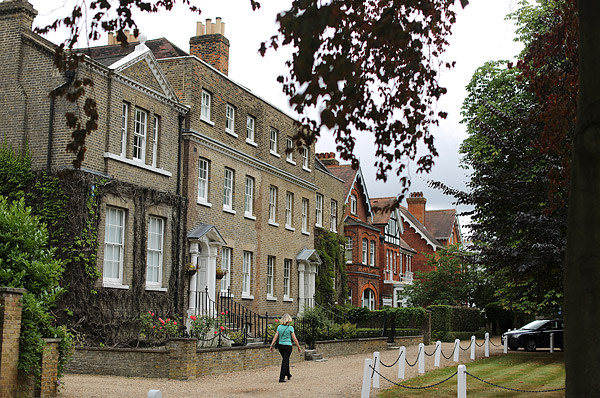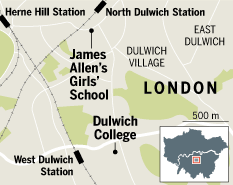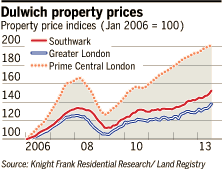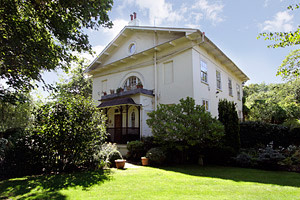Why Dulwich is top of the class for many parents looking to buy

Simply sign up to the Life & Arts myFT Digest -- delivered directly to your inbox.
While an Englishman’s home is generally accepted to be his castle, the residents of Dulwich Village must accept certain limitations to their freedom. For instance, they are not at liberty to pave their front gardens to create a parking space without prior written consent; nor can they install plastic windows. And, if their garden gets a little shabby, they might well face the wrath of the Dulwich Estate, the charity that controls this 1,500-acre swath of southeast London.
On the plus side, the estate’s rules – no intrusive tree houses or climbing frames, no peeling paintwork, among others – have helped to preserve the old-fashioned charm of Dulwich Village. It is a model suburb straight out of Central Casting, with verdant streets lined with pretty, period houses and white picket fences.
But ambitious parents are drawn to Dulwich not only for its looks. As well as insisting that homes are kept in good order, the estate – endowed in the 17th century by the actor and entrepreneur Edward Alleyn – has been instrumental in establishing a trio of top-performing independent schools.
In this year’s national GCSE league tables for independent schools, James Allen’s Girls’ School (JAGS) came 10th, Alleyn’s School came 32nd and Dulwich College came 41st. In the state sector, Dulwich Hamlet Junior School and Dulwich Village Church of England Infants’ School are both rated outstanding by Ofsted, England’s schools watchdog.

“The schools are the reason people come here – that, and the transport links, and the fact that it is very leafy,” says Jackie Starkin of Spencer Kennedy estate agents. “East Dulwich is buzzy, but Dulwich Village is just that bit more grown up.”
Dulwich is within the borough of Southwark, which over the past decade has seen prices rise by 70 per cent. It has comfortably outperformed Greater London, where average house prices rose 54 per cent in the same period. Since the recession, prices in Southwark have recovered to 15 per cent above 2007 levels, outdoing Greater London’s 10 per cent recovery. And – although there is no reliable data to prove this – it is more than possible that prices within Dulwich, one of the handful of equity-rich postcodes in the borough, may have risen even more strongly than these figures suggest.
According to Savills, the average property price across the whole of Dulwich is £548,000, although homes in the centre of Dulwich Village reach an average of £959,458.

On the ground, agents are reporting a strong Dulwich market – particularly in this year’s second quarter.
“We valued a two-bedroom flat [in March] at £350,000,” says Daryl Weston, sales manager of Ludlow Thompson, based in East Dulwich. In July the owner was ready to put it on the market and Weston thought it worthwhile to revalue it. This time he considered £400,000 a more appropriate price. Meanwhile, one-bedroom flats are regularly selling at more than the asking price. One recent property, priced at £300,000, went for £320,000, says Weston.
Homes in East Dulwich are almost uniformly Edwardian and Victorian. Weston says his buyers tend to be young professionals taking their first step on to the property ladder, buying either a two-bedroom garden flat (at between £350,000 and £400,000) or a house. A typical three- or four-bedroom terrace now costs between £700,000 and £900,000. In streets closest to the market and Lordship Lane, prices are reaching towards the £1m mark. For example, Winkworth is selling a four-bedroom Victorian semi-detached house on Ashbourne Grove for £1m.
Further afield, in West Dulwich, estate agent Kinleigh, Folkard & Hayward has a two-bedroom detached house on the market for £649,950.
Homes cost considerably more in the established village, which has a charming architectural make-up, from Georgian and high Victorian villas, to more modest period semis and terraces, with a dash of 1930s mock-Tudor thrown in.
At the top end are the lovely Georgian detached houses on Dulwich Village (confusingly, the name of one of the village’s best streets). These houses rarely come on to the market and cost upwards of £5m when they do – the entry price for Georgian houses elsewhere in the village is much lower. Savills is selling a six-bedroom Georgian house opposite Dulwich College, set in mature gardens, for a more typical £3m.

Another option, says Starkin, would be a Victorian villa, with five or six bedrooms, which typically sell for between £1.3m and £1.4m. Alternatively, 1930s semi-detached houses, with four or five bedrooms, are priced in the £1.2m to £1.4m range.
There are few flats in the middle of the village, although there are some two-bedroom maisonettes on the borders of East Dulwich, which sell at about £475,000.
As for buyers, Starkin says that most of her clients are professionals, particularly bankers, lawyers and doctors. Foreign investors are a rarity – Starkin estimates less than five per cent of buyers are from abroad.
——————————————-
Buying guide
● In August the crime rate for Dulwich village was 6.7 offences per 1,000 residents
● The average house in Dulwich is priced at £772,975
● Trains from Dulwich stations take about 15 minutes to central London
What you can buy for . . .
£750,000 A three-bedroom period semi in East Dulwich
£1.5m A four-bedroom postwar house in Dulwich Village
£3m A six-bedroom Georgian villa in Dulwich village
Comments